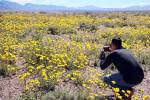Desert winter plants produce healthy fare
One of the best parts of being in Las Vegas’ Zone 8b climate is the ability to grow great food all year. If battling summer’s blazing sun is the hardest part of your gardening adventure, winter gardening might just be the place to start.
The average winter temperature is 52 degrees, according to the National Weather Service. But keep in mind that winter winds can whip your plants and frosts can kill them, so be sure to protect them.
“Winter gardeners should grow some of the many colorful and attractive varieties of — spinach, kale, collards, broccoli, lettuce, beets, radicchio, radishes, among others,” said Angela O’Callaghan, associate professor and social horticulture specialist with the University of Nevada Cooperative Extension.
What to grow
Think gardening is all about tomatoes and bell peppers? Think again.
Desert winter gardens produce some of the best staples of the diet: artichokes, asparagus, beets, broccoli, Brussels sprouts, cabbage, carrots, cauliflower, celery, Swiss chard, chives, collards, endive, garlic, horseradish, kale, kohlrabi, leeks, mustard greens, onions, parsley, parsnips, peas, radishes, rutabagas, spinach and turnips.
“My favorite winter crop is beets,” O’Callaghan said. “The leaves are very pretty as well as tasty, the roots are edible, and they will take much neglect.”
Where to grow it
You can recycle your plant beds from summer for a succulent winter garden, but be sure it’s in a location where you can protect it from the weather.
Las Vegas soil typically has low fertility and high salts. If your plant beds have good drainage (as they should), try watering them heavily; this will strip the salts from the soil, but it will also strip the nutrients. So add fertilizer and compost to build up the soil — this is what the plants feed on.
“The best way to get started is with compost,” O’Callaghan said, “especially for a winter garden, which will concentrate on leafy vegetables.
The Las Vegas Master Gardeners suggest adding peat moss, mature compost, potting mixes, composted biosolids (sludge), forest mulches (bark, pine needles, leaves) or composted manure (avoid dairy manure) to your soil.
If your ground is too hard and filled with caliche, consider building raised bed where you can add soil and compost without the salt.
Raised beds can be built with brick, wood or cement, need to be deep enough for your plant to build roots and narrow enough that you can reach the middle to care for the plants. The beds also need good drainage.
To build a raised bed, O’Callaghan suggests:
1. Place a layer of sand almost half the depth of the bed.
2. Add a layer of rotted organic matter about as thick as the layer of sand.
3. Add fertilizer with nitrogen, phosphorus and potassium.
4. Mix with a garden fork, spade or a rototiller.
5. Firm and level the soil; don’t pack it. Water thoroughly.
Watering
The most important part of a healthy garden is water.
Plant roots need to be kept moist and, thankfully, in the winter it requires a bit less of the desert’s most cherished commodity.
But what’s the best way to keep your plants hydrated?
Drip irrigation systems are affordable, easy and best for the environment. Set just below the soil, the water goes directly to the plant root system. Evaporation happens less with a drip irrigation system than with an above-ground sprinkler method and can be set to an automatic timer so it can be a self-watering system.
“In winter, water a little less often,” O’Callaghan said. “Just keep the soil evenly moist.”
Have questions?
Master Gardeners welcomes all questions at 702-257-5555 or lvmastergardeners@unce.unr.edu. Volunteers staff the help desk 9 a.m.-3 p.m. weekdays.































